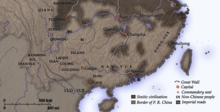Qin campaign against the Baiyue: Difference between revisions
→Background: Spelling/grammar correction |
|||
| Line 20: | Line 20: | ||
==Background== |
==Background== |
||
As trade was an important source of wealth for the Yue tribes of coastal China south of the Yangtze River. |
As trade was an important source of wealth for the Yue tribes of coastal China south of the Yangtze River. Attracted by its temperate climate, fertile fields, and relative security from the warring factions from the west and northwest, the wealth and access to luxury products from Southeast Asia motivated the [[First Emperor]] to send an army to conquer the Yue kingdoms. The emperor craved for the resources of the Baiyue and ordered military expeditions against the region between 221 and 214 BC.{{sfn|Holcombe|2001|p=147}}{{sfn|Gernet|1996|p=126}}<ref>{{Cite book |title=A Short History of China and Southeast Asia: Tribute, Trade and Influence |last=Stuart-Fox |first=Martin |publisher=Allen & Unwin |year=2003 |publication-date=November 1, 2003 |page=24-25}}</ref><ref name=Hutcheon>{{cite book|last=Hutcheon|first=Robin|title=China–Yellow|year=1996|publisher=Chinese University Press|page=4|ISBN=978-962-201-725-2}}</ref> |
||
In 214 BC, the '''[[Qin dynasty]]''' undertook a military campaign against the [[Baiyue]] to conquer the territories of what is now southern China and northern Vietnam. Emperor [[Qin Shi Huang]] secured his boundaries to the north with a fraction of his large army (300,000 men), and sent the majority (500,000 men) south to seize still more land. At that time, southern China was known for its fertile land, [[Elephant#Tusks|elephant tusks]] and [[jade]] production. Prior to the events leading to Qin dominance over China, the Baiyue had gained possession of much of [[Sichuan]] to the southwest. The Qin army was unfamiliar with the jungle terrain, and was defeated by the southern tribes' [[guerrilla warfare]] tactics, with over 100,000 men lost. |
In 214 BC, the '''[[Qin dynasty]]''' undertook a military campaign against the [[Baiyue]] to conquer the territories of what is now southern China and northern Vietnam. Emperor [[Qin Shi Huang]] secured his boundaries to the north with a fraction of his large army (300,000 men), and sent the majority (500,000 men) south to seize still more land. At that time, southern China was known for its fertile land, [[Elephant#Tusks|elephant tusks]] and [[jade]] production. Prior to the events leading to Qin dominance over China, the Baiyue had gained possession of much of [[Sichuan]] to the southwest. The Qin army was unfamiliar with the jungle terrain, and was defeated by the southern tribes' [[guerrilla warfare]] tactics, with over 100,000 men lost. |
||
Revision as of 02:48, 18 October 2017
This article needs additional citations for verification. (December 2015) |
| Qin's campaign against the Yue tribes | |||||||
|---|---|---|---|---|---|---|---|
 | |||||||
| |||||||
| Belligerents | |||||||
| Qin empire | Baiyue | ||||||
Background
As trade was an important source of wealth for the Yue tribes of coastal China south of the Yangtze River. Attracted by its temperate climate, fertile fields, and relative security from the warring factions from the west and northwest, the wealth and access to luxury products from Southeast Asia motivated the First Emperor to send an army to conquer the Yue kingdoms. The emperor craved for the resources of the Baiyue and ordered military expeditions against the region between 221 and 214 BC.[1][2][3][4]
In 214 BC, the Qin dynasty undertook a military campaign against the Baiyue to conquer the territories of what is now southern China and northern Vietnam. Emperor Qin Shi Huang secured his boundaries to the north with a fraction of his large army (300,000 men), and sent the majority (500,000 men) south to seize still more land. At that time, southern China was known for its fertile land, elephant tusks and jade production. Prior to the events leading to Qin dominance over China, the Baiyue had gained possession of much of Sichuan to the southwest. The Qin army was unfamiliar with the jungle terrain, and was defeated by the southern tribes' guerrilla warfare tactics, with over 100,000 men lost.
However, Qin did manage to construct the Lingqu Canal to the south, which they used heavily to supply and reinforce their troops during a second attack to the south. Building on these gains, the Qin armies conquered the coastal lands surrounding Guangzhou and took areas of Fuzhou and Guilin. After these victories in the south, the First Emperor moved over 100,000 prisoners and exiles to the newly conquered area to colonize them. Though the Qin emperor was victorious against the Yue kingdoms, Chinese domination was brief and the collapse of the Qin dynasty led the Yue peoples to regain their independence.[5]
By 208 BC, Zhao Tuo had reached Cổ Loa Citadel, capital of the state of Âu Lạc,[citation needed] 16 km (10 mi) northeast of present-day central Hanoi.[6] Then, he defeated An Dương Vương and established Nanyue kingdom during the same year.[7]
See also
References
- ^ Holcombe 2001, p. 147.
- ^ Gernet 1996, p. 126.
- ^ Stuart-Fox, Martin (2003). A Short History of China and Southeast Asia: Tribute, Trade and Influence. Allen & Unwin (published November 1, 2003). p. 24-25.
- ^ Hutcheon, Robin (1996). China–Yellow. Chinese University Press. p. 4. ISBN 978-962-201-725-2.
- ^ Stuart-Fox, Martin (2003). A Short History of China and Southeast Asia: Tribute, Trade and Influence. Allen & Unwin (published November 1, 2003). p. 24-25.
- ^ Ray, Nick; et al. (2010), "Co Loa Citadel", Vietnam, Lonely Planet, p. 123, ISBN 9781742203898.
- ^ Đại Việt sử ký toàn thư (Complete Annals of Đại Việt)
